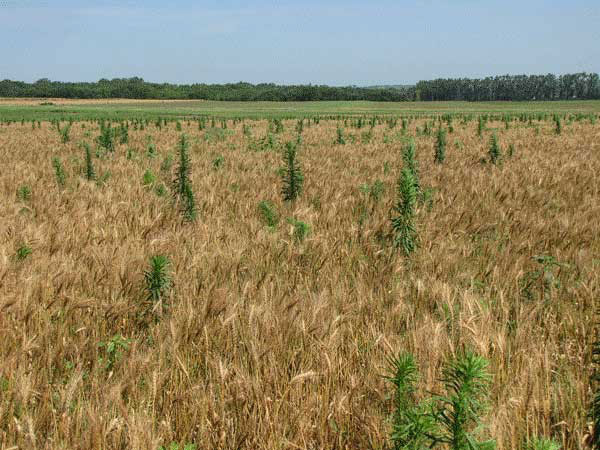This year’s short, thin wheat crop, coupled with late-season rains has resulted in a lot of questions about the best approach to managing large weeds in mature wheat. We did address this topic previously this year, but with the extended wheat harvest, it seems timely to share this information again. The weather will greatly affect how quickly the weeds will dry down to facilitate harvest. Because of the large size of some of the targeted weeds, there may not be complete control of the weeds and that can result in regrowth after harvest. In addition, there have been questions regarding the effect of some products, especially saflufenacil (Sharpen) on weed seed germination. We need to clarify that BASF data suggest that Sharpen does not negatively affect seed wheat and can be used on wheat that will be saved for seed.
Herbicides labeled for use as harvest aids in wheat are listed in Table 1. There are differences in how quickly they act to control the weeds, the interval requirement between application and grain harvest, and the level or length of control achieved. All of them will require thorough spray coverage to be the most effective. Paraquat is sometimes mentioned as a possible herbicide for pre-harvest application but is not labeled for pre-harvest treatment in wheat. Application of paraquat to wheat is an illegal treatment and can result in quarantine and destruction of the harvested grain, along with severe fines.

Figure 1. Weeds in wheat near harvest time. Photo by Dallas Peterson, K-State Research and Extension.
Table 1. Herbicides for use as pre-harvest weed control options in wheat.
|
Herbicide |
Weeds controlled |
Application timing |
PHI* (days) |
Comments |
|
Metsulfuron |
Some broadleaf weeds |
Hard dough stage |
10 |
Kochia, pigweeds, and marestail may be resistant Apply in combination with glyphosate or 2,4-D Use 0.25 to 0.5 % v/v nonionic surfactant) 12- to 34-month rotation interval for soybeans |
|
2,4-D LVE |
Broadleaf weeds |
Hard dough stage |
14 |
Weak on kochia and wild buckwheat |
|
Dicamba |
Broadleaf weeds |
Hard dough stage and green color is gone from nodes |
7 |
Do not use treated wheat for seed unless a germination test results in 95% or greater seed germination |
|
Glyphosate |
Grasses and broadleaf weeds |
Hard dough stage (30% or less grain moisture) |
7 |
Kochia, pigweeds, and marestail may be resistant |
|
Carfentrazone (Aim EC, others) |
Pigweeds, kochia, lambsquarters, Russian thistle, wild buckwheat |
|
7 |
Acts quickly, usually within 3 days Use 1% v/v crop oil concentrate |
|
Flumioxazin 1.5 to 2 fl oz |
Broadleaf weeds |
after wheat reaches the hard dough stage and g 30% or less grain moisture |
10 |
Acts quickly, usually within 3 days Use 1 qt/A MSO Tank mix with glyphosate recommended Rotation interval depends on rate and soil |
|
Saflufenacil (Sharpen) |
Broadleaf weeds |
Hard dough stage 30% or less grain moisture |
3 |
Acts quickly, usually within 3 days Use 1% v/v methylated seed oil + 1 to 2% w/v AMS or 1.25-2.5% v/v UAN Rotation interval depends on rate and soil |
*PHI = Pre-harvest interval, or days required between application and harvest.
For more detailed information, the “2023 Chemical Weed Control for Field Crops, Pastures, and Noncropland” guide is available online at
https://www.bookstore.ksre.ksu.edu/pubs/CHEMWEEDGUIDE.pdf or check with your local K-State Research and Extension office for a paper copy.
The use of trade names is for clarity to readers and does not imply endorsement of a particular product, nor does exclusion imply non-approval. Always consult the herbicide label for the most current use requirements.
Sarah Lancaster, Weed Management Specialist
slancaster@ksu.edu
Tags: wheat weed control pre-harvest